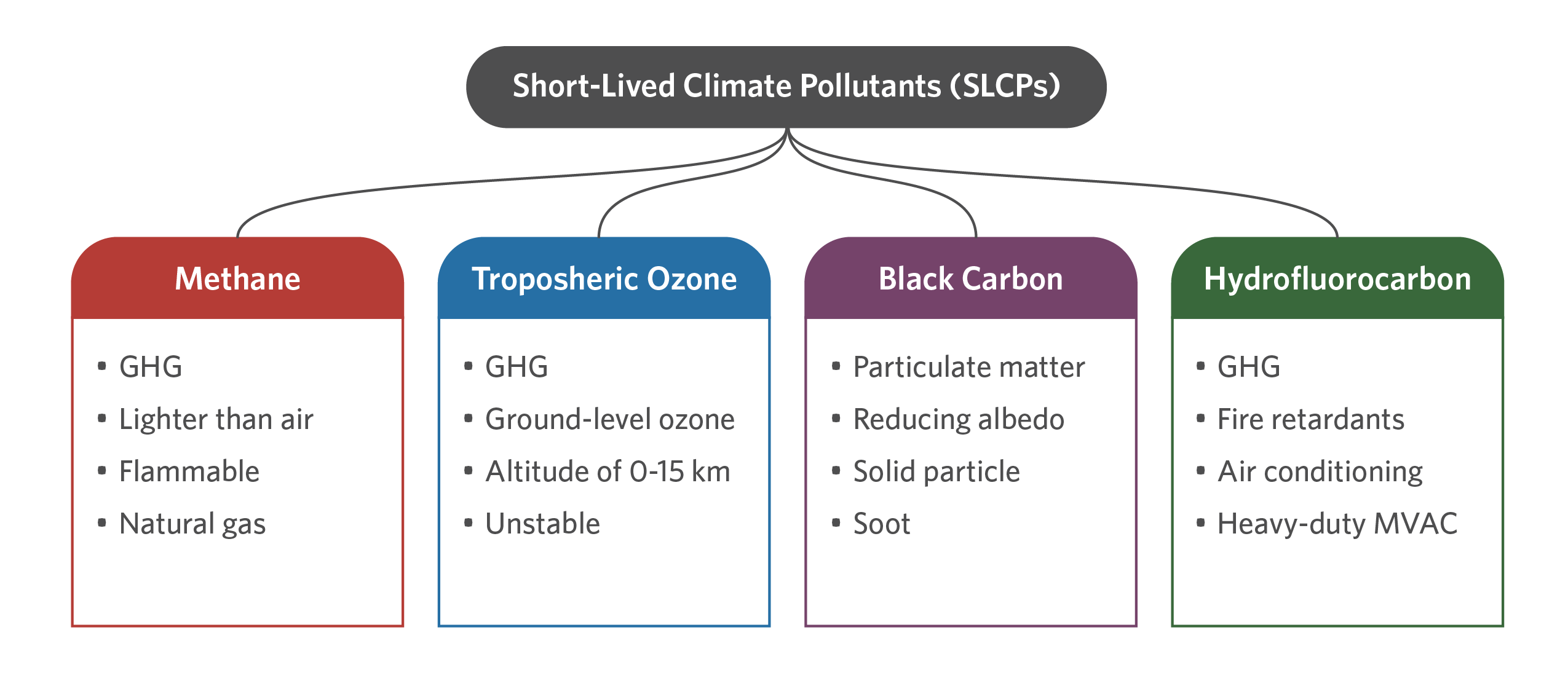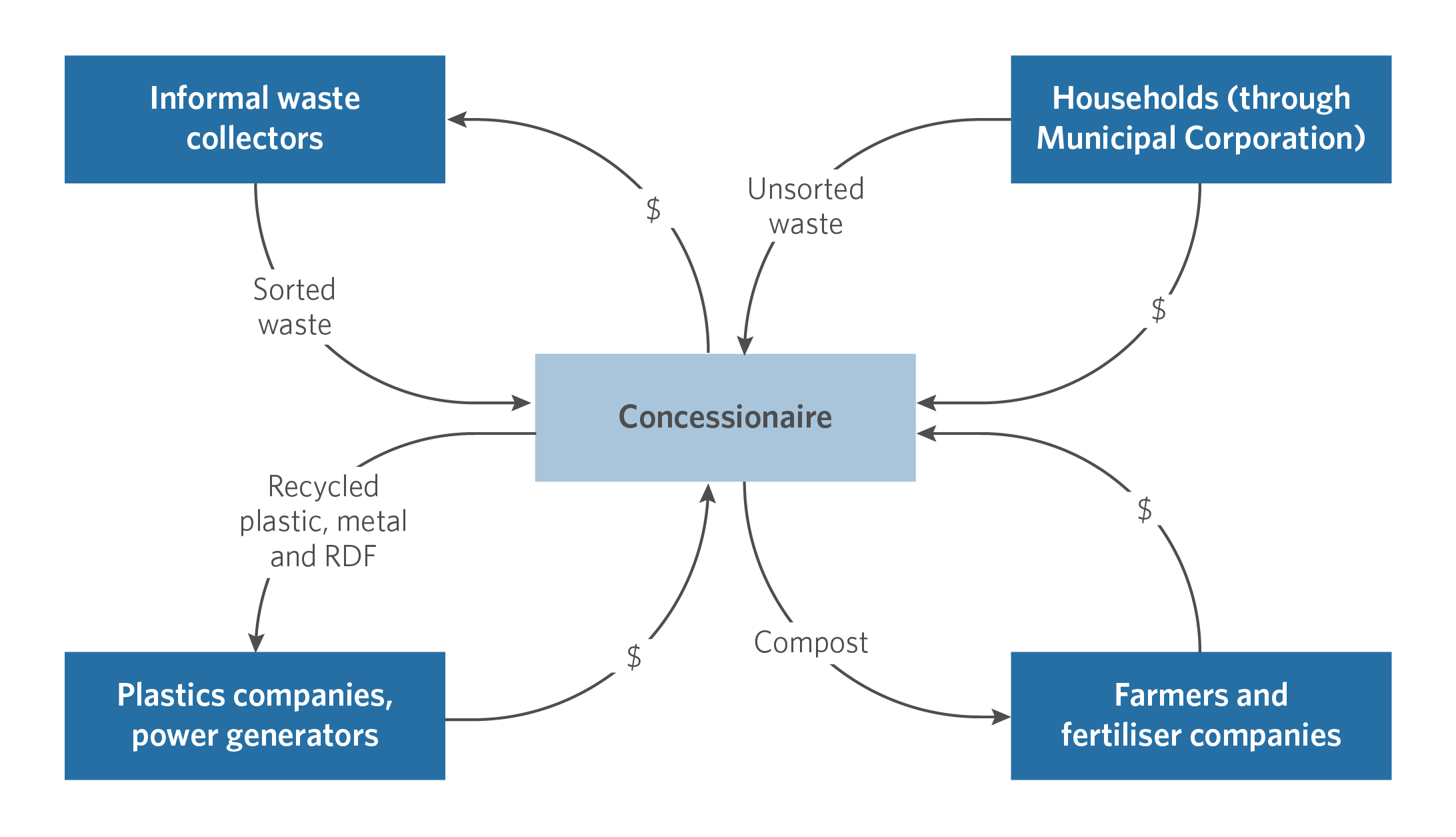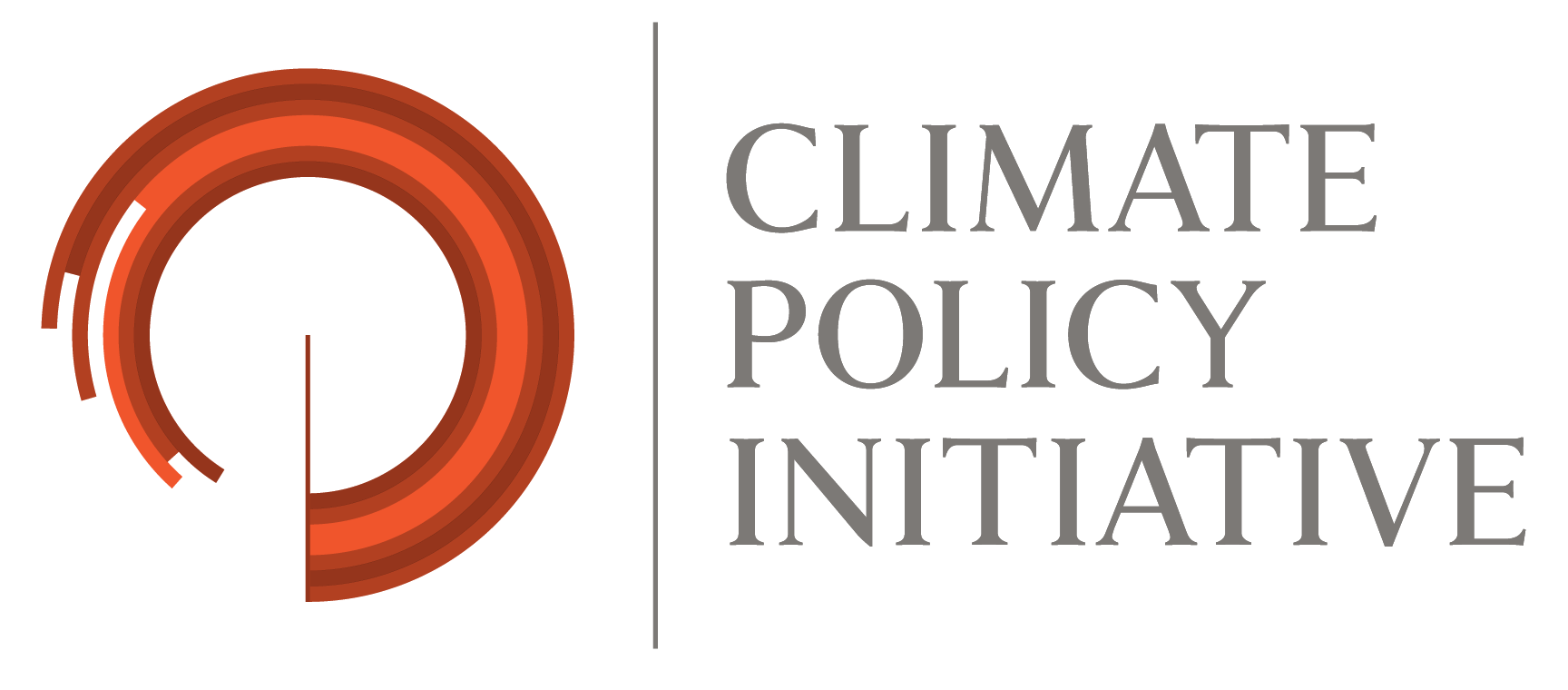Short-lived climate pollutants (SLCPs)—methane (CH4), black carbon, hydrofluorocarbons (HFCs), and tropospheric ozone—are among the most potent contributors to global warming. Their abatement, therefore, offers great potential to combat climate change.
With an alarming rise in air pollution across North India and Delhi, reducing these emissions is essential. Fostering an enabling policy and finance environment can spur more investment for their abatement across the country. A dedicated fund could also help to fast-track technologies that curb SLCPs, reaping great short-term mitigation results.
Short-lived climate pollutants: Why do they matter?
While SLCPs remain in the atmosphere for less time than carbon dioxide (CO₂), their global warming potential is significantly higher. Reducing them can reap immediate climate benefits, as well as many other co-benefits such as health and food security.
Figure 1: Features of SLCPs

The impacts of SLCPs are determined by their lifetime in the atmosphere and their ability to absorb energy, both of which combine to form their global warming potential (GWP). GWP measures the quantum of energy a unit ton of any greenhouse gases (GHGs) emitted would absorb relative to a unit ton of CO2 over a given period—either 20 years (GWP 20) or 100 (GWP 100). The GWP of SLCPs, shown in Table 1 below, illustrates their higher warming potential compared to CO2.
Table 1: Overview of SLCPs
| SLCPs | Lifetime in atmosphere | GWP20 | GWP100 | Negative effects | Sources |
| Methane (CH4) | 12 years | 81.2 | 27.9 | A critical short-term global warming accelerator with high heat-trapping power. Precursor to tropospheric ozone, which is a GHG and an air pollutant. | Enteric fermentation of livestockInundated paddy cultivationOilwells and leaking gas pipelines, coal mines, landfill dumps |
| Black carbon (global) | 4-12 days | 1,600 | 460 | Highly toxic to humans, increasing the risk of respiratory and cardiovascular diseases. Catalyzes global warming and impacts agricultural productivity by increasing stress on crops. | Burning of fossil fuelsAgricultural waste and gas flares |
| Tropospheric ozone | 1-3 weeks | 62 | 918 | Harmful pollutant that poses severe risks to human health, food security, and the ecosystem. Health effects include pulmonary and cardiovascular diseases, and others related to the nervous system. Impacts food production by damaging plant tissues and accelerating leaf aging. | Interaction of sunlight with volatile organic compounds—including CH4 —and nitrogen oxides (NOX) emitted largely by human activities. |
| HFC-32 | >10 years | 2,690 | 771 | Not ozone-depleting gases but highly potent GHGs with long-term atmospheric impacts. Some could induce reproductive and developmental toxicity in humans, and photochemical toxicity in plants. | Primarily used in refrigeration, air-conditioning, insulating foams, and aerosol propellants, with minor uses as solvents and for fire protection. |
| HFC-134a | 4,140 | 1,530 | |||
| HFC-143a | 7,840 | 5,810 | |||
| HFC-152a | 591 | 164 |
India’s SLCP emission shares
CH4 emissions have been increasing since 2000; fugitive emissions have increased by 94% (from 1,909 kiloton to 3,702 kiloton of CH4) followed by waste-related emissions by 43% (from 6,495 kilotons to 9,265 kilotons of CH4) and emissions from agriculture, forests, and other land use (AFOLU) which have increased by 6% (from 18,133 kilotons to 19,241 kilotons of CH4). While black carbon emissions have also increased since 2000, the levels of particulate matter (PM, which also constitutes black carbon) in prominent Indian cities remain far higher than World Health Organization limits. Primary drivers of black carbon in India have been the residential sector (47%), industry (22%), diesel vehicles (17%) and open burning (12%).
Figure 2: Emission trends of CH4 and black carbon in India (2000-2019)


Source: Climate and Clean Air Coalition
The urgency of SLCP mitigation
Effective mitigation of SLCPs can slow near-term climate change and also improve air quality, enhance public health, and strengthen food security:
- Climate-related impacts: SLCPs have shorter lifespans than CO2, but much higher GWPs. However, the UN Framework Convention on Climate Change (UNFCCC) measurement of SLCPs’ 100-year global warming potential (GWP100) understates these pollutants’ near-term climate impacts. Interpreting CH4 emissions over a century fails to emphasize their intense warming effects during their first two decades in the atmosphere. For example, while the GWP100 of CH4 emissions is 25-36 times greater than that of CO2, their GWP20 is 84-87 times greater. Focusing on the GWP20 of SLCPs highlights that fast mitigation action could help to avoid a ccontribute to 7 million annual premature delimate catastrophe within decades rather than centuries. SLCPs drive around 45% of current global warming, and rapid reduction could curb 0.6°C of warming by 2050. Furthermore, CH4 alone is responsible for about 16% of global anthropogenic GHG emissions.
- Multiple externalities: SLCP mitigation also yields co-benefits across food security, health, and climate resilience. These pollutants, particularly black carbon and tropospheric ozone, which are part of ambient air pollution, contribute to 7 million annual premature deaths. Tropospheric ozone damages crops and reduces their yields by 3-16%. Thus, a reduction in SLCPs would not only limit human morbidity and mortality related to respiratory ailments but also boost agricultural productivity, creating a multiplier effect that could be leveraged for achieving sustainable development goals.
Enabling financing for SLCP mitigation in India
In rapidly developing economies like India, SLCP mitigation must be integrated with relevant sectoral growth strategies to limit adverse impacts. Addressing the following constraints to financing SLCP mitigation can help:
- Policy focus: The global GHG mitigation narrative is overwhelmingly focused on CO2. Increasing policymakers’ understanding of the potential for SLCP abatement to support GHG mitigation, and even lead it in the short term, can help to prioritize related projects. For example, around 6% to 8% of all anthropogenic GHG emissions could be reduced if governments across the world took proactive steps to prevent the waste of food and its dumping in landfills. Governments in advanced economies have a greater onus in this regard since these countries account for more than 60% of global food waste.
- SLCP emissions data: Resolving the ambiguity in reported emissions across various data sources would create a more credible data foundation on which to base policies. While Global Methane Budget figures indicate that 84 million tonnes of global CH4 emissions are produced from oil and gas operations, only 38 million tonnes have been collectively reported by national governments to the UNFCCC. On the other hand, company-level reporting to the Oil & Gas Methane Partnership 2.0, the flagship oil and gas reporting and mitigation program of the United Nations Environment Programme (UNEP), captures global CH4 emissions of just 5% of the Global Methane Budget figure, with reporting from just one-third of global oil and gas suppliers.
- Collaboration among agencies on co-benefits: Mitigation of SLCPs would reap multiple co-benefits across health, agriculture, urban development, and the environment. This requires a ramping up of collaborative efforts to tackle SLCPs among authorities responsible for these areas. Currently, CH4 reduction initiatives in agriculture rarely converge with public health programs on air pollution. Harmonizing related governance frameworks could reduce duplication of efforts, enable more efficient resource allocation, and create opportunities to amplify impact through synergies.
- Economies of scale, particularly for bioenergy: Bioenergy projects in Indiaare small and disaggregated, resulting in high transaction costs and small ticket sizes. Enhancing the potential for portfolio approaches could make such projects financially attractive for institutional and large investors.
- Incentives to catalyze SLCP mitigation: India’s current policy landscape features significant gaps in incentivizing SLCP mitigation. For example, agricultural waste management has insufficient incentives for the collection and processing of paddy stubble and other crop residues, resulting in uncontrolled burning that releases black carbon. In addition, urban local bodies (ULBs) lack the financial capacity to implement waste management, hindering the reduction of CH4 emissions from landfills.
- Abatement costs: SLCP-mitigating technologies typically have high costs, both for equipment and for procuring feedstock or fuel. These costs often exceed the financial capacity of intended beneficiaries, deterring their adoption in developing economies. For example, one study found that clean cookstove prices of USD 15-50 were unaffordable for households that had earnings of USD 3-10 per day. While India’s Pradhan Mantri Ujjwala Yojana (PMUY) scheme is supporting low-income households to transition to LPG from kerosene and firewood cooking, 24% of beneficiaries could not afford to purchase a single LPG refill in their first year. Similarly, high feedstock costs hinder the adoption of pyrolysis of rural waste in India.
- Uncertainty around technical solutions: The nascent nature of most SLCP-abatement solutions gives rise to uncertainties over the quantum and timing of their outcomes. This increases risk perceptions of policy planners and financiers, on top of doubts related to the economic case for such technologies. For instance, the success of methane-mitigating direct-seeded rice hinges upon proper seedling embedding and root development in the soil, which brings uncertainties over crop yield and income for farmer collectives transitioning from inundated paddy cultivation. The practice also requires significant investment in specialized equipment. Similarly, the effectiveness of regenerative thermal oxidation—converting coal mine CH4 emissions into CO₂ and water—is uncertain since emissions from abandoned mines may not have sufficient CH4 concentration for the technology to work.
Ramping up India’s financing for SLCP mitigation
The technical and economic case for SLCP mitigation varies across pollutants, abatement technologies, and business models. All mitigation pathways require an enabling policy framework and approaches to unlock the necessary finance.
Policy
- Front-loading SLCP mitigation targets in existing country policies—e.g., Nationally Determined Contributions (NDCs) and National Action Plans for Climate Change (NAPCC)—would provide a clear policy directive to spur widespread initiatives with time-bound deliverables. Large nationwide programs would provide scale to draw interest from national, subnational, and municipal governments; technology suppliers and users; and public and private financiers. Champions of health, climate, and food security can pool their intellectual and financial capacities to co-design SLCP mitigation programs in order to capture these co-benefits.
- Identifying and structuring projects in impactful areas like waste management canlead to an immediate reduction in SLCPs emissions.Projects that convert disposable waste into revenue sources are complex and require comprehensive and meticulous structuring for the sustained participation of multiple stakeholders. Community composting projects, which have been promoted by India’s 2016 Solid Waste Management Rules, create visible economic value for households, thereby encouraging them to segregate their waste. At a larger scale, city authorities can structure projects as public-private partnerships (PPPs) to bring residents’ associations, project developers, and offtakers of compost and recycled plastic and metal into contract-bound partnerships with optimal allocation of returns and risks.

Ludhiana’s Municipal Corporation entered into a 25-year PPP agreement for a private concessionaire to collect and process waste generated in the city. The partnership gave the private operator exclusive ownership of waste and its continuous and unrestricted access in five zones of the city. The municipality also provided land free of charge for all related operations. The concessionaire could generate value by selling compost to farmers and fertilizer companies, recycled plastics and metals to industries and refuse-derived fuel to local power generators.
- Tailoring (dis)incentive structures for major SLCP-emitting sectors can promote cleaner technologies and practices. This isparticularly important for areas such as urban waste segregation and processing, transportation and mobility, and the oil and gas sectors. Disincentive structures would lead to the promotion of zero-emission trucking and electric mobility to minimize black carbon emissions and the implementation of time-bound regulations for the oil and gas sector to minimize CH4 leaks and eliminate routine flaring.
- Creating dedicated research hubs to accelerate innovation and capacity building, such as environmental management and policy research institutes, in order to fast-track the development and deployment of innovative solutions. They can also assist in building technical capacity among financial institutions to assess SLCP-related investments.
Finance
- Bridging data and information asymmetries through technical assistance can build investor confidence. Better overall reporting of emissions, as well as sharing data and insights on the performance of new technologies and successful business models, can provide comfort to investors vis-à-vis their exposure to SLCP mitigation projects. Focused project preparation support for market assessments and validation of technology and product quality can reduce perceived risks and attract investment. For example, promising technologies and business models providing potential solutions for black carbon abatement—e.g., pyrolysis of agri-residues—may need validation in order to access carbon finance.
- Leveraging international finance and multilateral partnerships to de-risk SLCP mitigation is crucial. Concessional finance from multilateral development banks and climate funds could catalyze private investment by sharing risks and reducing the cost of financing. The Global Environmental Facility has supported black carbon reduction initiatives in the past, and technical assistance from such funds could support the development of bankable projects.
- Developing innovative financial instruments tailored to SLCP mitigation would pave the way for increased investment. Intended outcomes can be assured by adopting results-based financing mechanisms such as the World Bank’s Pilot Auction Facility (PAF) for Methane and Climate Change Mitigation. This pay-for-performance mechanism has leveraged USD 53 million in public funds to catalyze USD 240 million in private investment to mitigate CH4 emissions from landfills and agricultural waste.
| Pilot auction facility for CH4 and climate change mitigation The World Bank’s Pilot Auction Facility (PAF) allocates a guaranteed price for future carbon credits in the form of a tradable put option. The put options give owners the right, but not the obligation, to sell the emission reductions achieved by underlying abatement projects to the PAF at a pre-agreed price. To purchase the put options, auction winners pay an option “premium” price upfront. |
A similar model could be adopted to finance municipal solid waste (MSW) management projects in India, where currently, on average, just 22% of MSW is remediated. This has led to a significant accumulation of waste in landfills, to which new waste gets added daily. The shortfall in waste processing capacity varies across ULBs as do their levels of financial buoyancy. Pooled green municipal bonds could be used to finance the enhancement of processing capacity across relevant ULBs. MSW projects by several ULBs could be bundled to enable smaller and less creditworthy bodies to access capital more easily and at lower interest rates. The credit structure could be made more robust by adding credit enhancements like escrow mechanisms, debt service reserve accounts, and guarantees. Successful water and sanitation pooled funds in states including Karnataka and Tamil Nadu could serve as examples to be emulated.
Way forward
Immediate action to abate SLCPs in the fossil fuel, agriculture, and waste management sectors can yield quick and tangible benefits for climate, health, and economic resilience. Strengthening policy frameworks, financing mechanisms, and cross-sectoral collaboration is key to unlocking the full potential of SLCP mitigation.

